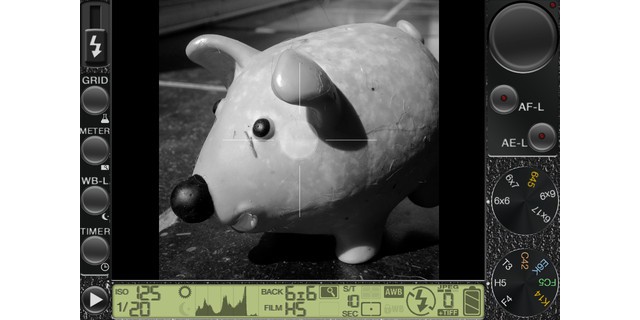645 Pro bills itself as an app which will turn your iPhone into a DSLR. At first glance, it seems like this has been achieved by mimicking the buttons and LCD panel of a modern SLR, and to an extent that’s true. But the real meat here is under the hood: 645 Pro shoots uncompressed JPEGs and TIFFs, and gives the closest that we’re likely to see to RAW images from the iPhone’s camera.
First, the features. [Yesterday](https://www.cultofmac.com/161747/shoot-raw-photos-on-the-iphone-with-645-pro/), I wrote in a preview that the interface looked very busy, with all the buttons and dials on-screen all the time. And that’s true. But these persistent buttons serve the same purpose as fixed buttons on a real camera: consistency. They are always there, and always where you expect them to be. Even advanced functions don’t resort to menus — you just press and hold the right button to set and forget.
In practice, it works well. The white balance lock also toggles between day and night mode, the grid button adjusts the quality settings of the saved files and the light meter button also switches the viewfinder between a live preview of the chosen “film” and a regular live view.

Over on the right, you can swap “backs” (change crop ratio) and choose different films. These have cute names like E6K, H5 and F4 and more. When you see them, it’s clear that these are modeled on Kodak’s Ektachrome (which is developed using the E6 process) and Ilford’s black and white emulsions FP4 and HP5.
Finally — concerning the controls — there are focus and exposure lock buttons, and a long press on the shutter release will lock both for 1.5 seconds, giving you the chance to reframe and shoot. Zooming is done by pinching, and the focus/exposure point is moved by tapping.
It works well, and suffers the same problems as a regular SLR: because things stay just as you set them, you will sometimes find yourself freaking out when you left a rogue setting dialed in. I did exactly that when making comparison shots for this review, shooting B&W with [645 Pro](https://jag.gr/645/) and color with the iPad’s own camera app.
Despite this, I like the app quite a lot, and once you get used to the faux LCD down at the bottom of the screen you will find the settings quick to change and use.
**Photo Quality**
The claim that 645 Pro shoots better images than any other camera might well be true. They’re the best that I have seen from my iPad 3. The app’s trick is not to apply post processing to the image data, rendering it as an uncompressed JPG (for use by other iPad apps) or as a TIFF file (for export via iTunes). A neat touch is that you can save both, with the JPG going to the Camera Roll and the TIFF saved for later import via iTunes.
So how is the quality? Pretty amazing. The difference is very clear even in the comparison between Camera.app’s JPGs and those from 645 Pro. Not only are there no artifacts, but the shots are cleaner, crisper and noticeably more detailed. Switch to TIFF and the differences are even bigger. Because the TIFF files are saved without the film effects applied, they look a little flat next to their accompanying JPGs — just like RAW files. But drop them into Lightroom and you’ll see that there is much more detail in the shadows, and blown-out highlights can be recovered to a surprising degree.
There is penalty in the form of file sizes. A typical iPhone 4 JPG weighs in at around 1-1.5MB. The uncompressed JPGs in my tests ranged from 3MB up to 6MB, with the TIFFs all coming in between 4MB and 5MB, depending on the subject.
This is the exact same tradeoff you make with any camera, though, and I’m glad to have the choice. Also, you can dial 645 Pro back to a lower setting, although the manual says that it never goes as low as the iPhone’s standard compression.
Note: I tested the app on an iPad 3, which pretty much has the lens of the iPhone 4S and the sensor of the iPhone 4. Right now, if you try to download and use the app on any iPad, including the new one, it won’t install. I forced it onto my iPad using the iPhone Configuration Utility, but the developer — Mike Hardaker — is looking into that. He says that there’s no reason that it shouldn’t run on any iOS device with an autofocus camera.
Would I recommend this app? Hell yes. Currently, it seems to be the only way to get full-quality images from your iPhone, and it costs just $3. I still find I prefer the $5 Mattebox I reviewed yesterday for quick shooting, but if you’re going to be sending your images over to say, Snapseed, for further processing, then the extra information in the images makes a huge difference.
**Pro:** Great quality images. A bargain price. Saves out TIFFs and JPGs of the same photo. Effects mimic real films. Live histogram.
**Con:** Ugly buttons for sharing photos. No iPad support (yet).
![645 Pro Takes The Best iPhone Photos You Have Ever Seen [Review] pro645.jpeg](https://www.cultofmac.com/wp-content/uploads/2012/04/pro645.jpeg)

